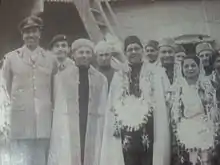Jahan Zeb of Swat
Miangul Jahan Zeb HPk, HQA, CIE (Urdu: ميانگل جهان زيب) (5 June 1908 - 14 September 1987), formally Miangul Abdul-Haqq Jahan Zeb, was the Wāli of Swat, a princely state that is now part of Pakistan, from 1949 to 1969. He succeeded his father, Wadud of Swat. He is remembered for building schools, hospitals and roads, but also for his absolute rule over the region, which ended when Pakistan took control of Swat after local unrest.[2][3] Jahan Zeb also worked to protect the landmarks of previous cultures.[4]
| Miangul Jahanzeb Khan | |
|---|---|
| CIE OMRI HPk HQA | |
 | |
| 2nd Wali of Swat | |
| Reign | 12 December 1949 - 28 July 1969 |
| Predecessor | Wadud of Swat |
| Successor | Miangul Aurangzeb (titular) |
| Born | 5 June 1908 Saidu Sharif, Yousafzai State of Swat, British India |
| Died | 14 September 1987 (aged 79) Saidu Sharif, NWFP, Pakistan |
| Issue | 4 sons and a daughter |
| House | Miangul Dynasty |
| Father | Wadud of Swat |
| Religion | Islam |
Early life and education

Jahan Zeb, born in Saidu Sharif on 5 June 1908, was the eldest son of Miangul Abdul Wadud. He was educated at the Islamia Collegiate School in Peshawar and at Islamia College, part of the University of Peshawar. He had four sons and one daughter: Miangul Aurang Zeb, Wāli Ahad of Swat, a former governor of Khyber Pakhtunkhwa and governor of Balochistan; Miangul Shahzada Alam Zeb, father of Miangul Akbar Zeb, the Pakistani high commissioner to Canada; Miangul Shahzada Amir Zeb, a member of the National Assembly of Pakistan in 1977,who also ruled swat in the absence of his father;[5] and Miangul Shahzada Ahmed Zeb.
Political career
Jahan Zeb was appointed Wāli Ahad in 1933. His father, the Wāli of Swat, eventually abdicated in favour of him, the eldest son, whom he had carefully educated along modern lines and gradually trained to assume the full burdens of government. Jahan Zeb was enthroned as Wāli of Swat on 12 December 1949.[6] In 1951, he was granted the title of Ghazi-e-Millat and a hereditary salute.
System of administration
The role of the Wāli was that of king and religious leader, chief minister and commander-in-chief, chief exchequer and head qazi.[6] He ensured that his government provided good administration and productive revenue collection; a judicial system that dispensed quick and free justice; a system of qala (forts) that lent security and protection to the people; and jobs, welfare, education and health services. Rapid communication through roads, bridges, and telegraph and penal codes provided rule of law, and telephones and informers kept the Wāli apprised of developments. This was a unique system of administration.[7]
Patronage of education
Jahan Zeb surpassed other contemporary rulers in the field of education. Before his era, Swat did not have a modern education system. His father laid the foundations of the system, which Jahan Zeb rapidly developed. He founded a girls' high school in Saidu Sharif, the first female educational institution in Swat.[6] Jahanzeb College for Men has the importance of Aligarh College in the entire Malakand division. He also established a missionary school for girls at Sangota.[8]
Patronage of archaeology
The Wali was keen to preserve the history of his principality and investigate its archaeology. In 1955 he invited the Italian Archaeological Mission in Swat to the valley under the leadership of the noted scholar Giuseppe Tucci.[9][10] In 1958 he sponsored the building of the Swat Museum, which contains exceptionally fine examples of Gandharan art and artifacts.[11]
Honours and awards
[12]==
- Hon. Major General, Pakistan Army (1955)
- Hon. LL.D. (University of Peshawar) (1965)
- Pakistan Independence Medal (1948)
- Hilal-i-Pakistan), 1961
- Great Leader (Hilal-e-Quaid-i-Azam) (1959)[13]
- Hilal-i-Humayun 1st class of Iran
- GO of the Order of Merit of the Republic of Italy
- Companion of the Order of the Indian Empire (1946)
- King George V Silver Jubilee Medal, 1935
- 15-gun salute, 1958
Death
Jahan Zeb died on 14 September 1987 in Saidu Sharif.[14] His funeral was attended by Prime Minister Muhammad Khan Junejo of Pakistan and other high officials. He was buried in his ancestral graveyard in Saidu Sharif.
References
- "What is Swat all about?". viewpointonline.net. Retrieved 20 April 2014.
- Massingberd, H. The Very Best of the Daily Telegraph Obituaries (Pan 2001), pp.26–8
- Swat’s Gandhara heritage waits to be protected Fazal Khaliq, 21 July 2010
- Notification. "Miangul Amirzeb" (PDF). National Assembly of Pakistan. Retrieved 13 May 2014.
- Aamir, Riaz (5 July 2009). "Malakand under Siege". Daily Jang, Rawalpindi. Retrieved 20 April 2014.
- Jilani, zebun-Nisa; Zeenat Ahmad. "Our Swat – Gone with the Wind". Swat relief initiative.
- Fazal Khaliq (26 September 2011). "Last ruler of Swat: Jahanzeb, a visionary who educated and loved his people". The Express Tribune. Retrieved 15 January 2014.
- (June 06, 2016). Miangul Jahanzeb remembered as visionary ruler of Swat. Dawn.
- Hamad Ali, Syed (January 24, 2018). Preserving Pakistan’s archeological heritage. Gulf News.
- Khaliq, Faisal (July 21, 2010). Swat’s Gandhara heritage waits to be protected. The Express Tribune.
- "About Swat Royal Family & Photographs". Apnaswat.com. 16 November 2010. Archived from the original on 24 December 2013. Retrieved 16 February 2014.
- "Decoration of medals Pakistan".
- www.valleyswat.net/literature/papers/Administrative_System_of_Swat.pdf
External links
Further reading
- Dr. Sultan-I-Rome, Swat State under the Walis (1917–69), Ph.D. Dissertation, P 28-35
- Miangul Jehanzeb, The Last Wali of Swat, as told to Fredrik Barth. Norwegian University Press/Universitetsforlaget AS, Oslo, 1985